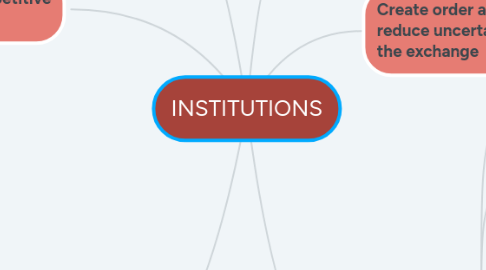
1. Determine
1.1. Profitability and variability of economic activity
1.1.1. Maximize profitability = cooperate
1.2. Transaction costs
1.3. Production costs
2. Solutions to competitive problems
2.1. Market exchange
2.2. Franchising
2.3. Vertical integration
3. Evolution
3.1. To evolve it is essential to invest time and resources to obtain knowledge and skills
3.2. YES
3.2.1. Innovation
3.2.1.1. + Capital mobility
3.2.1.1.1. Technical development, evolution of the bill of exchange, negotiation and discount
3.2.1.2. - Information costs
3.2.1.2.1. Price printing
3.2.1.3. + Risks
3.2.1.3.1. Uncertainty became risk with portfolio diversification
3.2.2. Interaction of 2 economic forces
3.2.2.1. Scale economy
3.2.2.2. Mechanisms for complying contracts to lower costs
3.2.3. The state
3.2.3.1. Regulation and integration between fiscal needs and commercial relations
3.3. NO
3.3.1. 1. Tribal society
3.3.1.1. Delicate balance of power
3.3.2. 2. Bazaar regional economy
3.3.2.1. Generalized and impersonal exchange
3.3.2.2. High cost measurement, continuous effort at clientization and intensive bargaining at every margin
3.3.3. 3. Caravan trade
3.3.3.1. Protection is essential but there is no order
3.4. Stability and change
3.4.1. Basic institutional framework, organized structure and institutional change
4. Political structure, economic and social interaction
4.1. Formal and informal restrictions
5. Create order and reduce uncertainty in the exchange
6. History
6.1. 1° Local exchange
6.1.1. Low cost transactions
6.2. 2° Regional exchange
6.2.1. Absence state-> order on the part of the religious
6.2.2. More resources for compliance and measurement
6.3. 3° Worldwide exchange
6.3.1. Low labor force, national and international markets
6.3.2. 2 problems in transaction costs
6.3.2.1. Trust
6.3.2.1.1. Family members were used as business delegates
6.3.2.2. Negotiation and contracts
6.3.2.2.1. Transport security
6.4. Economy
6.4.1. Scale economy
6.4.1.1. Higher specialization and division of labor
6.4.1.1.1. Gives way to urbanization
6.4.1.2. Organization of hierarchical production
6.4.2. Capital market
6.4.2.1. Security for property rights
6.4.2.2. Tolerant and moderate rulers in strength
6.4.2.3. Manufacturing growth
6.4.2.3.1. Effective factor and product markets
6.5. Highly specialized forms of transport
6.5.1. Generate
6.5.1.1. ORGANIZATIONS
